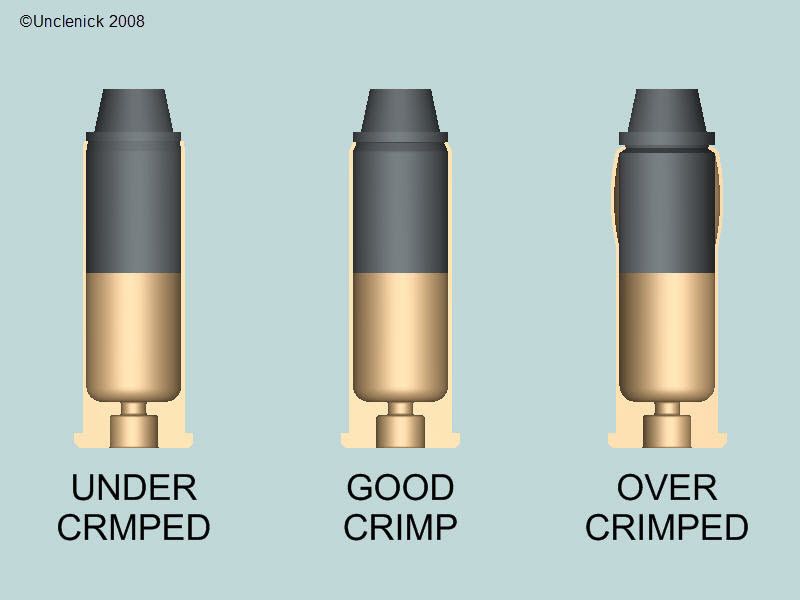Gunny12,
Let me refresh your memory a little.
Cartridge brass has thickness tolerances, and not all brands have the same thickness. In order to make one sizing die that will successfully resize all brands of brass means it must be made small enough to resize the thinnest brass adequately. For that reason, plus allowing for repeatedly resized brass to become more springy as it work hardens, sizing dies have to be made to resize average brass and thick brass too much. This makes it too narrow for the bullet, so sizing is followed by an expander to make the inside diameters correct for bullet seating.
A rifle cartridge with a bottleneck can have its expander inside the sizing die because the case is clear of the part of the die that resizes the neck when the expander starts acting on it. But if a case is designed with straight sides, like your .44 Special, that clearance won't exist when the case is inside the die. Even if the die uses a carbide sizing ring at its mouth that leave room above the ring for an expander, you would just iron that expansion back out again when you withdrew the case from the die. So expanding straight wall cases has to be done in a separate operation on a separate die after sizing. On the plus side, the separate expander die can be made hollow, so if you have primed the case on the downstroke after resizing, you can put the powder charge in the case right through the die.
The die set you are thinking of buying will have a roll crimp shoulder built into the seating die body. You adjust how much, if any, of that crimp you use when you set up the seating die. Many folks do not use the crimp in the seating die because it tends to shave a little metal off the bullet because it is still moving into the case as the crimp is formed. This leaves little shaved ring of bullet metal at the mouth of each case. Even commercial jacketed ammunition often has these. Folks who find this objectionable instead prefer to have a separate crimping die that is a 4th operation, or they set their seated bullets aside without crimping, then remove the seating stem from the seating die and use just the die body as a separate crimp die, so it crimps without pushing the bullet any deeper.
That latter method is extra adjusting, so many just get the separate crimping die. At that point you can choose between a taper crimp and a roll crimp. Roll crimps are commonly used in revolvers because they hold the bullet more firmly than a taper crimp does. Revolvers firing rimmed cartridges or rimless cartridges using moon or half moon clips have a special problem that auto pistols do not share. When the revolver fires, recoil pushes back on the cylinder which pushes back on the rims (or clips) of all the remaining cartridges in it. Inertia wants to make the bullets tend to stay where they are, and if the recoil is sharp enough, that inertia will pull the bullet out as the case goes backward. I think of it as the bullet being "pantsed" by the recoil. If a bullet comes out far enough to stick out of the cylinder, it will jam rotation of the cylinder. A roll crimp does the best job of preventing this.
On the other hand, if your loads are light target loads and the revolver is one with some heft, and not a snubby or other light weight carry gun, you may find it never develops recoil sharp enough to pants the rounds in the cylinder. In this instance you can get away with a taper crimp. I did this for many years firing .38 wadcutters and .357 cased wadcutter loads in my S&W K-frame target revolver and my Dan Wesson 15-2, respectively. The brass is then good for many more reloadings before the case mouths start to split. This is the main advantage of the taper crimp.
However, for my Charter Bulldog .44 firing full power .44 Specials I had to use a roll crimp. Today, my personal opinion is the Redding Profile Crimp die is the best choice for these. The advantage it has is it lets you apply a roll crimp harder than you can do with standard dies. This is because it constrains the brass just below the case mouth so it cannot bell outward during crimping, as can happen with a regular seating/crimping die. The third image from left in my drawing, below, shows this greatly exaggerated. Such a bulge from over-crimping can prevent a round from chambering and actually holds the bullet less firmly because the side friction is gone.
Finally, instruction videos. If you are going to buy Lee dies, use Lee's instruction videos. They are:
Sizing die setup and adjustment.
Expanding die setup and adjustment.
Seating Die setup and adjustment.
